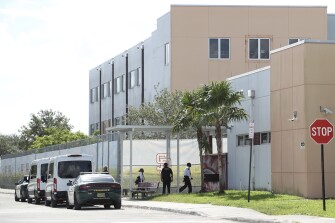Six years after a former student shot and killed 17 people in a Parkland, Fla., high school, crews began to demolish the bloodstained building, which had become both a painful reminder of the tragedy and a symbol of advocacy efforts led by the victims’ families.
Family members of students and educators who died in the Feb. 14, 2018 shooting at Marjory Stoneman Douglas High School—the deadliest high school shooting in U.S. history—have led political leaders, including Vice President Kamala Harris and U.S. Secretary of Education Miguel Cardona, on tours of the damaged freshman classroom building, walking past bullet holes and classrooms frozen in time as they made the case for stronger school safety efforts.
Many of those same grieving loved ones stood under white tents outside the three-story building as workers used a large excavator to begin chipping away at its walls. The Broward County district expects it will take weeks to destroy and remove the structure from the multi-building site.
“When the crane hit the building, it just honestly ignited that pain even further,” Lori Alhadeff, who joined the Broward County School Board after her daughter, Alyssa, died in the shooting, told reporters in a June 14 press event livestreamed by the Associated Press.
“I know this is part of our healing process, and I want the building to come down, but I just keep thinking of my beautiful daughter Alyssa and the 16 others who were murdered on Valentine’s Day six years ago. It’s really been a rollercoaster of pain and grief.”


The district left the building in place pending court proceedings for the gunman, who pled guilty and received 34 consecutive life sentences. Members of the jury toured the building as they deliberated his sentence in August 2022, walking past handwritten student assignments strewn on the floor and Valentine’s Day roses that had shriveled and dried on students’ desks.
After they got approval to demolish the building, district officials opted to delay work until students were dismissed for the summer. They plan to complete the task before students return for the 2024-25 school year.
Since the shooting, Stoneman Douglas students have also walked past the building, which was surrounded by a fence wrapped in vinyl banners, as they head to class in the school’s other buildings. The district plans to build a permanent memorial on the site when it is fully cleared. Families engaged in the planning process have suggested outdoor learning spaces, sculptures, or a “legacy field” to celebrate the victims’ lives without focusing on the tragic way they died.
“We don’t want something that memorializes the day they were taken, because they were so much more than that,” Tony Montalto, whose daughter, Gina, was killed in the shooting, told reporters Friday.
Building became a symbol of school safety advocacy
Other districts have also razed school buildings after school shootings.
Newtown, Conn., opened a new school on the grounds of Sandy Hook Elementary School four years after the 2012 shooting there. In Littleton, Colo., officials demolished the Columbine High School library, the primary site of a 1999 shooting by two students.
The Uvalde, Texas, school district started construction in October 2023 on a new building to replace Robb Elementary School, where 19 students and two teachers were killed in 2022. Like Broward County, the Uvalde district has left the previous structure in place pending legal proceedings.


But Parkland victims’ families have also taken the unusual step of walking back into the building, enduring waves of emotions in order to tour the space with congressional delegations and U.S. officials. They’ve called for more federal money for school threat assessment and security features like better locks, communications systems, and ballistic glass windows in classroom doors so that attackers can’t target students from hallways.
“What’s also upsetting is that I wasn’t able to bring more people through that building,” Max Schachter, whose son Alex died in the shooting, told reporters as workers started tearing the building down.
Schachter has toured the building 10 times, taking more than 500 public officials and school district leaders through the hallways and past the bloody chair where Alex was shot. He said he was still getting requests for site visits as the demolition plans were finalized.
“Every time it’s excruciatingly painful,” Schachter said. “But it’s difficult to understand the magnitude of the failures unless you are walking through that building.”
The surviving family members formed Stand With Parkland, an organization that has successfully advocated for state and federal laws like the STOP School Violence Act, which provided additional federal funding for school safety measures. They’ve called for laws to promote “responsible firearms ownership,” like universal background checks for gun purchases, and for mental health support and school safety enhancements.
When Montalto toured the building with officials, he would point out a bundle of pipes under a first floor stairwell that led to fire sprinklers throughout the building, he told Education Week in April. School fires are rare, but buildings are carefully constructed to avoid them. Shouldn’t officials be just as intentional with other safety efforts? he said.
While walking through the hallways was difficult, “it gave me a chance to tell people about my daughter,” Montalto said.










